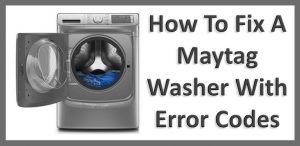
The “OE” error code on a Maytag washing machine typically indicates a drainage issue. Imagine it like this: your washing machine is trying to empty the water from the tub after a wash, but something is stopping it — like a blocked sink struggling to drain water. Ignoring this error might seem tempting, especially if it doesn’t disrupt your day-to-day routine immediately. But just like ignoring a slow-draining sink can lead to bigger plumbing headaches, leaving this error unaddressed can result in more significant problems with your washing machine over time.
Understanding the “OE” Error: What It Means and What Causes It
The “OE” error is essentially your washing machine’s way of saying, “Hey, I’m having trouble draining here!” This could happen due to a few common reasons. It might be as simple as a kinked drain hose, which is like someone pinching your garden hose while you’re trying to water your plants — it disrupts the flow. Alternatively, there could be a blockage inside the hose itself, similar to a clogged straw making it hard to sip your drink.
Sometimes, the problem might lie in the pump filter. Consider this like a lint trap in your dryer; if it’s clogged, it can’t do its job properly. Over time, bits of fabric, stray coins, and other debris can accumulate, leading to drainage issues. In other cases, it might be a malfunctioning drain pump — the part responsible for pushing the water out. Think of this as a pump that’s lost its “oomph” and can’t push the water as it should.
Why You Shouldn’t Ignore the “OE” Error
You might be asking yourself, “What’s the worst that could happen if I ignore this error?” Picture this: ignoring drainage issues is like sweeping dirt under the rug. Sure, it might look clean temporarily, but eventually, the problem will resurface — often in a bigger, more troublesome way. If the washing machine can’t drain properly, it can lead to water left in the tub, which might result in a musty smell, similar to leaving wet clothes in a bag for too long.
In more severe cases, ignoring this error could lead to water leaks. Imagine trying to carry a bucket of water with a hole in it; not only will you lose water, but you’ll also create a soggy mess. Similarly, a persistent drainage problem can eventually cause water to spill out, damaging your flooring and anything else nearby. Plus, standing water in your machine can lead to mold growth and other hygiene issues, making your laundry less fresh and more of a chore.
Another thing to consider is the strain on your washing machine’s components. When your machine struggles to pump out water, it’s working harder than necessary, which can eventually lead to wear and tear. Just like driving your car with a flat tire, you’re only risking more damage and more costly repairs down the line.
Steps to Take if You Encounter the “OE” Error
So, what should you do if you see this pesky error code? First, don’t panic. Approach this calmly, like solving a small puzzle. Start by checking the drain hose. Is it kinked or bent? Straightening it out might just do the trick. Next, inspect the hose for any clogs by detaching it and giving it a good rinse. Think of it like cleaning out a straw to ensure your drink flows smoothly.
If that doesn’t solve it, the next step is to check the pump filter. This usually involves accessing a small door near the bottom of your machine, locating the filter, and cleaning out any debris. It’s a bit like cleaning out your lint trap — a straightforward, albeit slightly messy task.
Should these initial steps not resolve the issue, it might be time to call in a professional. There’s no shame in seeking help when things get tricky. A technician can diagnose more complex issues, such as a faulty pump, and suggest appropriate solutions.
Preventative Tips to Keep the “OE” Error at Bay
Preventing this error from occurring in the first place can save you a lot of hassle. Regular maintenance is key, much like changing your car’s oil to keep it running smoothly. Make it a habit to check and clean your drain hose and pump filter periodically. This simple act can go a long way in preventing blockages.
Another tip is to avoid overloading your washing machine. Doing so is like trying to stuff a suitcase with too many clothes — it puts unnecessary strain on the machine’s components, especially the drainage system. Be mindful of what goes into your wash; empty pockets and avoid washing overly dirty items without pre-rinsing them.
Lastly, if you’re using powdered detergent, ensure it’s dissolving completely. Undissolved detergent can contribute to clogs, just like sugar granules that don’t dissolve in your coffee make it gritty. Switching to a liquid detergent might also help in preventing such buildups.
In conclusion, while it might be tempting to overlook the “OE” error for the time being, addressing it promptly can save you from a cascade of related issues. It’s like nipping a small problem in the bud before it blooms into a bigger headache. By understanding the cause, taking immediate action, and embracing preventative measures, you’ll help ensure your Maytag washing machine runs smoothly and efficiently for years to come.